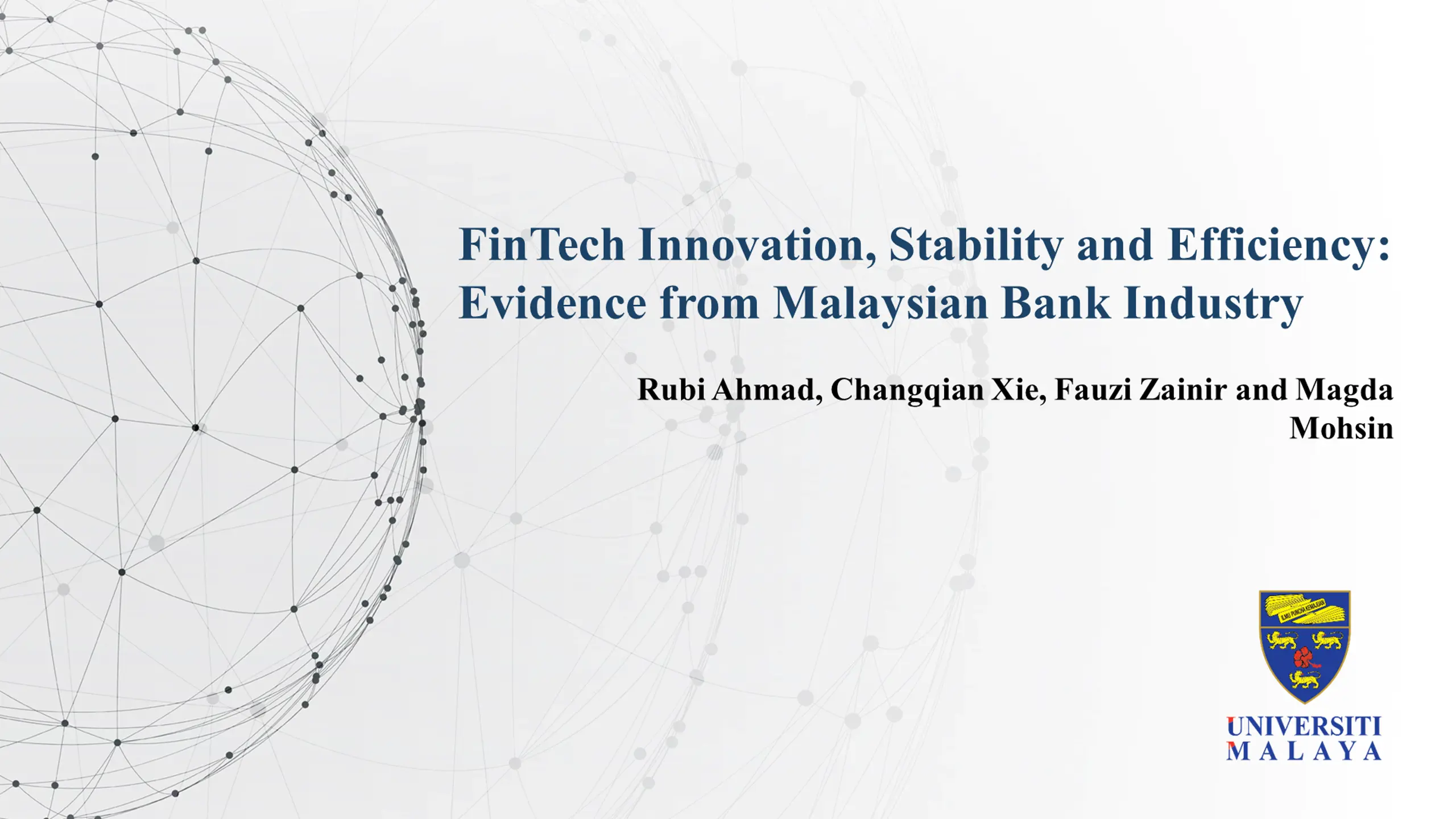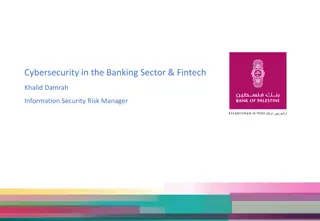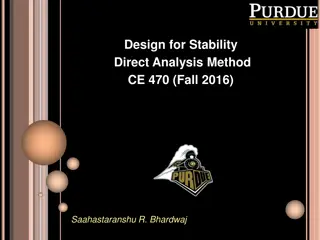FinTech Innovation, Stability, and Efficiency
FinTech innovation influences the stability and efficiency of the traditional banking sector in Malaysia. It provides empirical evidence and covers different types of banks in Malaysia, including commercial and Islamic banks.
Download Presentation

Please find below an Image/Link to download the presentation.
The content on the website is provided AS IS for your information and personal use only. It may not be sold, licensed, or shared on other websites without obtaining consent from the author.If you encounter any issues during the download, it is possible that the publisher has removed the file from their server.
You are allowed to download the files provided on this website for personal or commercial use, subject to the condition that they are used lawfully. All files are the property of their respective owners.
The content on the website is provided AS IS for your information and personal use only. It may not be sold, licensed, or shared on other websites without obtaining consent from the author.
E N D
Presentation Transcript
FinTech Innovation, Stability and Efficiency: Evidence from Malaysian Bank Industry Rubi Ahmad, Changqian Xie, Fauzi Zainir and Magda Mohsin
1 Introduction Literature Review and Hypothesis Development 2 CONTENTS 3 Data and Methods 4 Results and Discussion 5 Conclusion
1 PART Introduction
Research background Increasing supply Bank Negara Malaysia issued the digital bank licenses to five applicants on 29thApril 2022 Malaysia became the second country in ASEAN to issue digital bank licenses 02 Increasing demand The Increasing demand for online financial services during the Covid-19 pandemic (Murinde, Rizopoulos, & Zachariadis, 2022). 01 Challenges & Opportunities How financial technology influences the stability and efficiency of the traditional banking sector in Malaysia?
Contributions 1) This study provides empirical evidence for Malaysia and similar developing countries with an open hug for FinTech development but with relatively less advanced technology infrastructure. 2) The samples in this study cover different types of banks in Malaysia, including commercial banks and Islamic banks, which provide a comprehensive view of the Malaysian banking sector.
Limitations The data that can be used to purely measure technological progress is still not available. the banks The Malaysian banking industry limits the broad applicability of findings. uniqueness of the
2 PART Literature Review & Hypothesis Development
2.1 Definition of FinTech innovation FinTech is defined as a form of financial innovation triggered by advanced technologies such as cloud computing, big data, blockchain, and artificial intelligence, which may result in new business models, applications, processes or products, and further has a material effect on the provision of financial services (CGFS & FSB, 2017). This definition has also been adopted by the Basel Committee on Banking Supervision (BCBS). Despite its current rapid growth (Goldstein, Jiang, & Karolyi, 2019), there is still no clear conclusion about its influence (Lee et al., 2021). We know innovation creates not only new markets by bringing about new products and services but also replaces existing markets, which is the creative destruction theory coined by Schumpeter (2010). This theory can also apply to the study of FinTech. Hence, past studies on the impact of FinTech innovation on the financial industry draw two views -- the innovation-growth hypothesis and the innovation-fragility hypothesis (Beck, Chen, Lin, & Song, 2016).
The innovation-growth hypothesis supports that FinTech innovation improves the functions of the financial system and has a positive effect on traditional finance. Examples : FinTech innovation fosters risk sharing (Allen & Gale, 1994) and increases economic growth (Beck et al., 2016; Laeven, Levine, & Michalopoulos, 2015). From the perspective of the innovation-fragility hypothesis, FinTech innovation disrupts the equilibrium of the existing financial system by introducing new forms of financial risks and challenging the existing financial regulatory system (Zhang, 2020). Hence, the risk of the financial system is significantly increased. Examples : Triggers an excessive credit expansion (Brunnermeier, 2009),increases the volatility of bank profitability (Beck et al., 2016), and affects the effectiveness of traditional monetary policy (Odularu & Okunrinboye, 2009).
2.2 Overview of FinTech Innovation in Malaysia We refer to the financial inclusion index provided by Meng describe the development in Malaysia. The index is based on the Financial Access Survey (FAS) data released by IMF in 2019 It is relatively stable, but reached a maximum value of 0.0427 in 2009 It is between the average levels of countries and developed countries (2020) to FinTech developing
2.3 Hypothesis development Hypothesis 1 (H1): There is a positive relationship between FinTech innovation and bank stability. Hypothesis 1A (H1a): Compared to Islamic banks, the positive impact of FinTech innovation on banks stability is more significant in commercial banks. Hypothesis 2 (H2): There is a positive relationship between FinTech innovation and bank efficiency.
3 PART Data and Methods
3.1 Sample selection Oribis Bank Focus Database Consists of 36 banks (8 local commercial banks, 8 local Islamic banks, 15 foreign commercial banks, and 5 foreign Islamic banks) Sample period: 2006 to 2020 Final sample of 393 bank-year observations, unbalanced panel data
3.2 Variable description: DV Bank stability Z-score=(??? + ???)/?(???) The higher Z-score implies more stability Bank efficiency ? 1??,?? ?? ? 1?? 1,?? 1 ?? ?(?? 1,?? 1) ? 1= (1) ??? ?????????? ?? ?(??,??) ?= (2) ??? ?????????? ?? 1/2 ? 1(??,??) ?(??,??) ?? ? 1(?? 1,?? 1) ?? ?(?? 1,?? 1) (3) ??? ??????????= ?? ?? According to the definition of DEA-Malmquist, if the number calculated from equation (3) is > 1, it means that the total factor productivity (TFP) of banks has increased from period t-1 to t; otherwise, it means that the banks TFP has decreased.
Table 4: The average DEA-Malmquist score of banks in Malaysia (2006-2020). Period Local commercial Local Islamic Foreign commercial Foreign Islamic Full sample 2005-2006 0.9962 1.1302 1.0536 2006-2007 1.0482 1.0295 1.0402 2007-2008 1.0740 1.1485 1.1059 2008-2009 1.0141 0.8770 0.9553 2009-2010 1.0256 1.1420 1.0755 2010-2011 1.0458 0.9785 1.0170 2011-2012 1.0018 1.1770 1.1191 1.0010 1.0899 2012-2013 0.9984 0.9795 1.0001 1.0606 1.0066 2013-2014 1.0148 1.1315 1.3464 1.0399 1.1824 2014-2015 1.0372 1.0296 1.1052 1.0130 1.0605 2015-2016 1.0253 1.2159 1.0515 1.1528 1.0963 2016-2017 1.0129 1.1255 1.0008 1.0613 1.0396 2017-2018 1.0044 1.0036 1.2585 1.0223 1.1126 2018-2019 0.9958 0.9506 0.8547 0.9028 0.9140 2019-2020 1.0098 1.0108 1.1475 0.9587 1.0603 Average 1.0203 1.0693 1.0793 1.0236 1.0540
3.2 Variable description: FinTech innovation Challenges: 1) The data on R&D expenditures or patents are typically not collected or disclosed by financial institutions 2) Not a unified method is concluded - Some studies use FinTech indexes provided by professional research institutions and others use text-mining technology to collect FinTech-related keywords on the Internet to construct FinTech indexes. FinTech2 FinTech1 Defined as total value of other intangible assets divided by total assets for each bank each year (%). Defined as the total value of off- balance-sheet items divided by total assets for each bank each year (%) (Beck et al., 2016) Fintech2_DUM If the FinTech2 is missing data, equals to one, otherwise, zero. Fama and French (2015); Flannery and Rangan (2006)
3.2 Variable description: FinTech innovation The relationship between FinTech1 and FinTech2 a positive correlation (0.6212)
3.2 Definition of variables Variable Definition Equals to the natural log of (ROA+CAR)/ (ROA), the standard deviation of ROA is over the sample period for each bank. The higher Z-score implies less risk-taking and more stability. Stability Equals to the score of DEA-Malmquist. Efficiency The total value of off-balance-sheet items divided by total assets for each bank each year (%). FinTech1 The total value of other intangible assets divided by total assets for each bank each year (%). FinTech2 Dummy variable, if the FinTech2 is missing data, equals to one, otherwise, zero. FinTech2_DUM The natural logarithm of a bank's total assets (in RM Ringgit million). The value of liquid assets divided by total assets for each bank each year (%). The value of total equity divided by total assets for each bank each year (%). Equals to the Cost to income (Efficiency) ratio (%) obtained from BankFocuse. Size Liquidity CapitalStructure CostToIncome Ratio of non-interest income to total operating income for each bank each year (%). IncomeDiversification
3.3 Research method We employ the multivariate panel data regression model to test the research hypotheses. (4) ??????????,?= ??????? ?,?+ ??????????,?+ ??+ ??+ ??,? (5) ???????????,?= ??????? ?,? 1+ ??????????,? 1+ ??+ ??+ ??,? The subscripts i and t represent the individual bank and year, respectively. The coefficient ? and ? measure the effect of FinTech innovation on banks risk- taking and efficiency. The regression model includes bank fixed effect to control any potential bias due to omitted variables in the panel datasets and year fixed effect to control potential temporal effects. We winsorize the top and bottom 1% of the continuous variables to control the outlier bias.
3.4 Descriptive statistics FinTech1: mean value (35.3051%), range from minimum value (27.1160%) to maximum value (183.1608%), which suggests considerable heterogeneity in FinTech development in the years of Malaysian banks.
3.4 Descriptive statistics Table 7 reports the correlation matrix of the identified variables. Overall, the correlation matrix does not suggest any serious multicollinearity concerns. Stability Efficiency FinTech1 FinTech2 FinTech2_DUM Size Liquidity CapitalStructure CostToIncome IncomeDiversification Stability Efficiency FinTech1 FinTech2 FinTech2_ DUM Size Liquidity CapitalStr ucture CostToInc ome 1 -0.0334 -0.0579 -0.2128*** 1 -0.0536 -0.0766 1 -0.0336 1 -0.0433 0.0896* 0.0825 -0.4998*** 1 0.2001*** -0.1114** -0.1380*** 0.1481*** 0.0124 0.0741 0.1658*** -0.2264*** -0.2178*** 0.2725*** 1 -0.4845*** 1 0.0211 0.0136 0.0361 -0.0466 0.0629 -0.5430*** 0.4292*** 1 -0.2698*** -0.0003 -0.1692*** 0.3674*** -0.0778 -0.3232*** -0.0072 0.1381*** 1 IncomeDiv ersification -0.0673 0.0206 -0.2036*** -0.1143** 0.0712 -0.2259*** 0.0699 -0.0890* 0.2120*** 1
4 PART Results and Discussion
4.1.1 FinTech innovation and bank stability (1) (2) (3) (4) (5) Dependent variable: Stability Expected Sign FullSample- FE 0.0001 (0.0003) -0.0920** (0.0414) -0.0019** -0.0022*** (0.0007) 0.0747*** 0.0723*** 0.1130*** 0.0993*** 0.0694*** (0.0044) (0.0038) (0.0122) -0.0025*** -0.0022*** -0.0026*** -0.0021*** -0.0029*** (0.0005) (0.0005) (0.0006) 0.0004 0.0013** -0.0009 (0.0006) (0.0006) (0.0009) 3.9020*** 3.8401*** 2.4440*** 3.1405*** 4.0615*** (0.4625) (0.4571) (0.2370) Yes Yes Yes Yes Yes Yes 36 23 13 0.9282 0.9491 0.8659 393 275 118 Commercial- FE 0.0005* (0.0003) -0.0934** (0.0386) Foreign- FE 0.0001 (0.0004) -0.1350** (0.0578) -0.0012* (0.0006) Islamic-FE Local-FE -0.0004 (0.0005) 0.0492 (0.0297) -0.0009 (0.0008) 0.0002 (0.0004) -0.008 (0.0554) -0.0017 (0.0014) FinTech1 + Size +/- 1) Only in the regression of subsample (commercial banks, Liquidity + (0.0008) column 2), supporting H1a CapitalStructure + (0.0098) (0.0044) 2) There is obvious heterogeneity in CostToIncome + (0.0006) 0.0004 (0.0005) (0.0007) -0.0004 (0.0013) the impact of FinTech IncomeDiversification - development on bank stability. _cons (0.6911) Yes Yes 16 0.9204 193 (0.631) Yes Yes 20 0.9439 200 Individual bank Year Number of banks R-squared (within) Observations
4.1.2 FinTech innovation and bank efficiency (1) (2) (3) (4) (5) Dependent variable: Efficiency Expected Sign FullSample- FE 0.0010* (0.0005) 0.1175* (0.0644) 0.0043 (0.0030) 0.0022 (0.0017) -0.0014 (0.0014) -0.3587 (0.7007) Yes Yes 36 0.1292 357 Commercial- FE 0.0003 (0.0005) 0.0826 (0.0654) 0.0070** (0.0027) 0.0002 (0.0024) -0.0023 (0.0022) -0.0043 (0.7329) Yes Yes 23 0.1723 252 Islamic- FE 0.0009 0.0006 0.0018*** (0.0009) (0.0009) (0.0006) 0.1145 0.1447* 0.1595** (0.1475) (0.0760) (0.0678) -0.002 0.0053** 0.0053 (0.0068) (0.0024) (0.0039) 0.0042 0.0025 (0.0027) (0.0023) (0.0023) 0.0006 -0.0019 (0.0024) (0.0013) (0.0021) -0.2132 -0.723 (1.4601) (0.8814) (0.7311) Yes Yes Yes Yes 13 16 0.2125 0.1810 105 177 Local- FE Foreign- FE l.FinTech1 + In column (1), the coefficient of FinTech1 is positive and l.Size +/- significant at the 10% level; l.Liquidity + In column (5) it is positive and 0.0026 l.CostToIncome + significant at the 1% level H2 is only significant for our full -0.001 l.IncomeDiversification + sample and foreign bank sample -0.7733 _cons data leading us to conclude that Individual bank Year Number of banks R-squared (within) Observations Yes Yes 20 0.1963 180 full sample results are driven by foreign banks
4.2.1 Endogeneity concern: GMM (1) (2) (3) Foreign bank- GMM Dependent Variable: Efficiency Commercial bank-GMM Full sample-GMM Dependent Variable: Efficiency Dependent Variable: Stability 0.4126* (0.2311) L.Stability -0.3368*** (0.0533) 0.0013* (0.0007) 0.1563* (0.0802) 0.0051* (0.0030) -0.3854*** (0.0583) 0.0022*** (0.0008) 0.2406*** (0.0777) 0.0062* (0.0036) L.Efficiency These results are consistent 0.0040** (0.0016) 1.5012** (0.6912) -0.0017 (0.0014) 0.1448*** (0.0311) 0.0007 (0.0018) FinTech1 with the baseline regression Size results, which further Liquidity confirm H1a and H2. CapitalStructure 0.0018 (0.0018) 0.0023 (0.0019) CostToIncome 0.0012* -0.0016 0.0004 IncomeDiversification (0.0007) -14.8869* (8.177) Yes Yes 23 0.0335 0.3290 1.0000 229 (0.0022) -0.4427 (0.9021) Yes Yes 36 0.0001 0.6541 1.0000 321 (0.0023) -1.1642 (0.8266) Yes Yes 20 0.0017 0.2032 1.0000 160 _cons Individual bank Year Number of banks AR (1) AR (2) Sargan test Observations
4.2.2 Replacing the dependent variable Stability2 equals to the natural log of (ROAA+CAR)/ (ROAA), where the standard deviation of ROAA is over the sample period for each bank, and the ROAA is the rate of return on average assets. Efficiency2 equals to the DEA-Malmquist score calculated by three input variables (labour, fixed assets, and total deposits) and three out variables (total loans, other earning assets, and non-interest income), referring to Lee et al. (2021). (1) Full (2) (3) (4) (5) (1) Full Sample- FE 0.0004 (0.0004) 0.0938 (0.0591) 0.0017 (0.0030) 0.0043** (0.0020) (2) (3) (4) (5) Dependent variable: Stability2 Commercial- FE 0.0006** (0.0002) -0.0814* (0.0440) -0.0016** (0.0006) 0.0699*** (0.0042) Islamic- FE -0.0004 (0.0005) 0.0357 (0.0330) -0.0010 (0.0008) 0.1137*** 0.1104*** 0.0648*** (0.0082) (0.0061) - 0.0020*** 0.0030*** (0.0006) (0.0006) -0.0003 -0.0004 (0.0005) (0.0004) 2.4814*** 2.7756*** 3.9339*** (0.2823) (0.3942) Yes Yes Yes Yes 13 16 0.9206 0.9640 118 193 Foreign- FE 0.0002 (0.0004) -0.1253** (0.0560) -0.0007 (0.0005) Dependent variable: Efficiency2 Local-FE Commercial- FE Islamic- FE Local- FE Foreign- FE Sample-FE 0.0002 (0.0003) -0.0831* (0.0424) -0.0016** (0.0006) 0.0718*** (0.0048) 0.0004* (0.0002) 0.0200 (0.0324) -0.0011 (0.0010) FinTech1 0.0010* (0.0005) 0.1076 (0.0651) 0.002 (0.0040) 0.0045* (0.0026) 0 -0.0005 (0.0008) 0.114 (0.1415) -0.0081 (0.0057) 0.0057 (0.0036) 0.0002 (0.0004) 0.1886* (0.0941) 0.0030** (0.0011) 0.0050* (0.0027) - 0.0037** (0.0016) -1.172 (1.0406) Yes Yes 16 0.2177 177 l.FinTech1 (0.0004) 0.0723 (0.0555) 0.0055** (0.0026) 0.0023* (0.0013) Size l.Size Liquidity l.Liquidity CapitalStructure (0.0038) - 0.0030*** (0.0006) 0.0002 (0.0009) - l.CostToIncome -0.0031*** -0.0033*** CostToIncome (0.0006) 0.0004 (0.0005) 3.7976*** (0.4676) Yes Yes 36 0.9375 393 (0.0008) 0.0006 (0.0007) 3.7380*** (0.5124) Yes Yes 23 0.9519 275 -0.0029* -0.0033 -0.0007 -0.0025 l.IncomeDiversification IncomeDiversification (0.0016) -0.0668 (0.6058) Yes Yes 36 0.1626 357 (0.0024) 0.0771 (0.5672) Yes Yes 23 0.1838 252 (0.0028) 0.0862 (1.4218) Yes Yes 13 0.2908 105 (0.0024) -0.1936 (0.6198) Yes Yes 20 0.2228 180 _cons _cons (0.5747) Yes Yes 20 0.9511 200 Individual bank Year Number of banks R-squared (within) Observations Individual bank Year Number of banks R-squared (within) Observations
4.2.4 Additional analysis: size effect (1) (2) (3) (4) Stability Big Size 0.0003 (0.0002) 0.0249 (0.0384) -0.0002 (0.0009) 0.1104*** 0.0665*** (0.0046) -0.0031*** -0.0025*** (0.0004) -0.0001 (0.0005) 2.6305*** 3.3918*** (0.4654) Yes Yes 0.9700 240 Stability Efficiency Efficiency Small Size Big Size Small Size -0.0002 0.0001 (0.0006) (0.0005) -0.0599 0.1434** (0.0625) (0.0614) -0.0009 0.0047** (0.0007) (0.0020) 0.0024** (0.0009) 0.038 (0.1436) 0.0027 (0.0088) FinTech1 Overall, the impact of FinTech innovation on banks Size stability and efficiency Liquidity varies by bank size. CapitalStructure (0.0042) 0.0043 (0.0027) -0.0025 (0.0016) -0.7646 (0.6879) Yes Yes 0.2353 222 0.0017 (0.0034) -0.0025 (0.0038) 0.7689 (1.2432) Yes Yes 0.1235 135 Big-sized banks are defined as those with total assets exceeding the median value of 36 banks total assets. Small-sized banks are those less than the median value. CostToIncome (0.0006) 0.0005 (0.0007) IncomeDiversification _cons (0.5747) Yes Yes 0.9483 153 Individual bank Year R-squared (within) Observations
4.2.4 Additional analysis: profitability effect (1) (2) (3) (4) Columns (1) show that banks with high Stability High ROE 0.0003* (0.0002) 0.0475 (0.0305) -0.0013 (0.0008) 0.1070*** (0.0080) -0.0025*** -0.0034*** (0.0007) 0.0009* (0.0005) 2.4176*** (0.3686) Yes Yes 0.9612 227 Stability Low ROE -0.00003 (0.0005) -0.1230* (0.0651) -0.0017* (0.0009) 0.0661*** (0.0043) Efficiency Efficiency High ROE Low ROE -0.0003 (0.0006) 0.00005 (0.0884) -0.0067 (0.0094) 0.0071 (0.0045) 0.0017 (0.0024) ROE have significantly improved their 0.0020*** (0.0004) 0.1748* (0.0837) 0.0111** (0.0052) 0.0002 (0.0030) -0.0052 (0.0034) stability with higher development of FinTech1 FinTech. Size However, banks with low ROE enjoy a significant effect of improving efficiency Liquidity brought by FinTech, as shown in column (4) CapitalStructure CostToIncome Banks in the high ROE group are (0.0010) 0.0001 (0.0006) 3.9263*** (0.6349) Yes Yes 0.9446 166 defined as those whose ROE exceeds the IncomeDiversification median ROE of the sample banks, and 0.9420 (1.015) Yes Yes 0.1607 209 -0.6698 (0.8309) Yes Yes 0.1920 148 those in the low ROE group are on the _cons contrary. Individual bank Year R-squared (within) Observations
5 PART Conclusion
Conclusion Compared with Islamic banks, FinTech innovation significantly improves the stability of commercial banks 1 FinTech innovation has a more significant effect on improving foreign banks efficiency than local banks 2 These baseline results are affirmed using the GMM approach to mitigate potential endogeneity issues 3 Heterogeneity analysis: the high-profit banks enjoy the benefits of improving their stability level from FinTech development. However, for the small-sized and low-profit banks, FinTech innovation contributes more to improving their efficiency. 4
Implications The impact of Financial innovation on Malaysian traditional banks is therefore heterogeneous. For example, the big-sized and high-profit banks enjoy the benefits of improving their stability level from FinTech development while the small-sized and low- profit banks, more to improving their efficiency. When looking at the growth of financial innovation and its impact on bank stability and efficiency, it is essential to investigate this relationship thoroughly from different standpoints and under various conditions. A need for financial regulatory authorities to update their financial supervision methods in real-time, as the wide usage of FinTech increases the business complexity of banks.
Main reference Thakor, A. V. (2020). Fintech and banking: What do we know?. Journal of Financial Intermediation, 41, 100833. Beck, T., Chen, T., Lin, C., & Song, F. M. (2016). Financial innovation: The bright and the dark sides. Journal of Banking & Finance, 72, 28-51. Murinde, V., Rizopoulos, E., & Zachariadis, M. (2022). The impact of the FinTech revolution on the future of banking Opportunities and risks. International Review of Financial Analysis, 102103. Lee, C. C., Li, X., Yu, C. H., & Zhao, J. (2021). Does fintech innovation improve bank efficiency? Evidence from China s banking industry. International Review of Economics & Finance, 74, 468-483. Hu, D., Zhao, S., & Yang, F. (2022). Will fintech development increase commercial banks risk- taking? Evidence from China. Electronic Commerce Research, 1-31. Ahamed, M. M., & Mallick, S. K. (2019). Is financial inclusion good for bank stability? International evidence. Journal of Economic Behavior & Organization, 157, 403-427. Wang, R., Liu, J., & Luo, H. (2021). Fintech development and bank risk taking in China. The European Journal of Finance, 27(4-5), 397-418.























